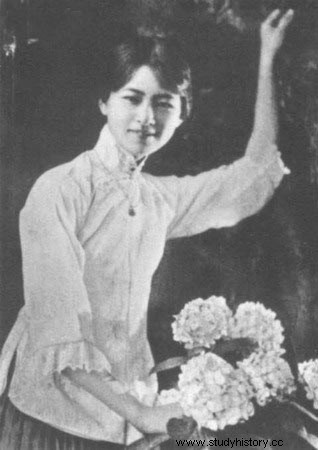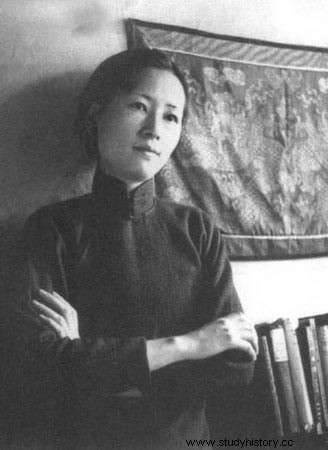Lin Huiyin, also known as Phyllis Lin or Lin Whei-yin (1904 – 1955) is considered the first female architect in modern China. She leads with her husband an important work of census and safeguard of Chinese architecture.
Study abroad

Daughter of He Xueyuan and Lin Changmin, Lin Huiyin was born in Hangzhou on June 10, 1904, although her family originated from Minhou in Fujian, on the southeast coast of China. She comes from a privileged background, which allows her to study in China, then to travel with her father and continue her training in the United Kingdom and the United States.
In London, Lin Huiyin enrolled at St Mary's College. There she meets the poet Xu Zhimo, who falls in love with her. The young man is a prisoner of an arranged marriage and Lin, for her part, has been engaged by her father to Liang Sicheng, whom she has known since childhood; the similarity of their experiences brings the two young people together. Their relationship inspires the poet many poems. Lin also writes, notably free verse and novels. His works will be published in various magazines.
In 1924, Lin Huiyin and her fiancé Liang Sicheng enrolled at the University of Pennsylvania. They are both passionate about architecture, but only Liang is admitted to the faculty of architecture; Lin's application is not accepted because she is a woman. Otherwise, the young woman enters the School of Fine Arts. Subsequently, she studied design at Yale and took courses in architecture.
Architect and historian

After graduation, Lin and her husband return to China. In 1928, she designed a railway station in Jilin. In Shenyang, she helped establish a department of architecture within the university, and taught there briefly. After the Mukden incident of September 18, 1931, a pretext for the invasion of Manchuria by Japan, Lin moved to Beijing where she taught architecture.
In Beijing, Lin and her husband carry out an important work of historical study of ancient Chinese architecture. In 1936, as part of this work, Lin was the first woman to climb onto the roof of the Temple of Heaven. The following year, she discovered the main hall of the Foguang temple near Doucun, in Shanxi in northeastern China.
War
In 1937, the Japanese invasion of China forced Lin Huiyin and her husband to leave Beijing and abandon the important work of restoring the city's cultural heritage that they had undertaken. With their children, they exiled themselves to the south and settled in Tianjin, Kunming and then Lizhuang, in Sichuan in central-western China.
In 1941, Lin's younger brother, Lin Heng, died in an aerial battle. Very affected, bedridden by tuberculosis, she dedicated a poem to him:"My brother, I don't have the words to mourn your death. This era has sent you a simple request, and you have answered it. Your simple and absolute heroism is a poem of this time. I want to add sadness to this inevitable reality by shouting – you understand why – that you left too soon. Mo, brother, your courage is immense. Your death is too cruel. »
After the war
After the war, in 1949, Lin Huiyin took a job teaching architecture at Tsinghua University in Beijing. She and her husband continue their work of studying and preserving ancient Chinese architectural heritage; together they write a book on the subject and work to preserve Beijing's ancient buildings.
Lin participates in the design of the Chinese national flag, the emblem of the People's Republic of China and the monument to the People's Heroes, an obelisk located in Tiananmen Square; she designs the floral motifs at the base of the monument. It also contributes to Beijing's urban planning.
Lin Huiyin died of tuberculosis in 1955, at the age of 50.
